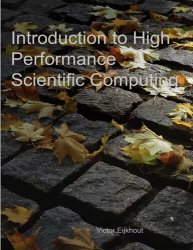The Science of Computing: Volume 1 (Introduction to High-Performance Scientific Computing), 3rd Edition
- Добавил: literator
- Дата: 7-06-2025, 16:28
- Комментариев: 0
 Название: The Science of Computing: Volume 1 (Introduction to High-Performance Scientific Computing), 3rd Edition / The Science of Computing: The Art of High Performance Computing, Volume 1, 3rd Edition
Название: The Science of Computing: Volume 1 (Introduction to High-Performance Scientific Computing), 3rd Edition / The Science of Computing: The Art of High Performance Computing, Volume 1, 3rd EditionАвтор: Victor Eijkhout
Издательство: Independently published
Серия: The Art of High Performance Computing
Год: April 2, 2024
Страниц: 503
Язык: английский
Формат: pdf (true)
Размер: 45.1 MB
This book has the general background knowledge for scientific computing: computer architecture, parallel computer architecture, computer arithmetic, linear algebra, ODE/PDEs, and how it all comes together in big computations.
This volume contains general theory of scientific computing. It takes a holistic approach to scientific computing: assuming that the reader is an application scientist, this book instills the knowledge necessary to bridge the gap between science and efficient computations.
Part 1 covers theoretical topics: Architecture of a single computer and parallel, Computer arithmetic, Numerical linear algebra, Ordinary and partial different equations, and finally bringing all these topics together in the Computational analysis of a number of algorithms.
Part 2 covers some applications such as molecular dynamics, sorting, graph analysis.
Part 3 has tutorial appendices, introducing the basic concepts of graph theory, linear algebra, partial differential equations and such.
The field of high performance scientific computing lies at the crossroads of a number of disciplines and skill sets, and correspondingly, for someone to be successful at using high performance computing in science requires at least elementary knowledge of and skills in all these areas. Computations stem from an application context, so some acquaintance with physics and engineering sciences is desirable. Then, problems in these application areas are typically translated into linear algebraic, and sometimes combinatorial, problems, so a computational scientist needs knowledge of several aspects of numerical analysis, linear algebra, and discrete mathematics. An efficient implementation of the practical formulations of the application problems requires some understanding of computer architecture, both on the CPU level and on the level of parallel computing. Finally, in addition to mastering all these sciences, a computational scientist needs some specific skills of software management.
While good texts exist on numerical modeling, numerical linear algebra, computer architecture, parallel computing, performance optimization, no book brings together these strands in a unified manner. The need for a book such as the present became apparent to the author working at a computing center: users are domain experts who not necessarily have mastery of all the background that would make them efficient computational scientists. This book, then, teaches those topics that seem indispensible for scientists engaging in large-scale computations.
Machine Learning (ML) is a collective name for a number of techniques that approach problems we might consider ‘intelligent’, such as image recognition. In the abstract, such problems are mappings from a vector space of features, such as pixel values in an image, to another vector space of outcomes. In the case of image recognition of letters, this final space could be 26-dimensional, and a maximum value in the second component would indicate that a ‘B’ was recognized. The most popular form of ML these days is Deep Learning (DL), or neural networks. A neural net, or a Deep Learning network, is a function that computes a numerical output, given a (typically multi-dimensional) input point.
Скачать The Science of Computing: Volume 1 (Introduction to High-Performance Scientific Computing), 3rd Edition
[related-news] [/related-news]
Внимание
Уважаемый посетитель, Вы зашли на сайт как незарегистрированный пользователь.
Мы рекомендуем Вам зарегистрироваться либо войти на сайт под своим именем.
Уважаемый посетитель, Вы зашли на сайт как незарегистрированный пользователь.
Мы рекомендуем Вам зарегистрироваться либо войти на сайт под своим именем.
